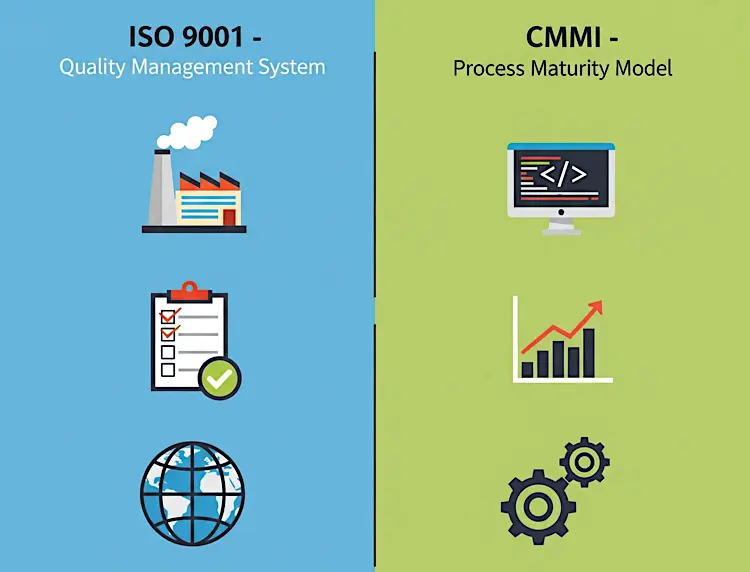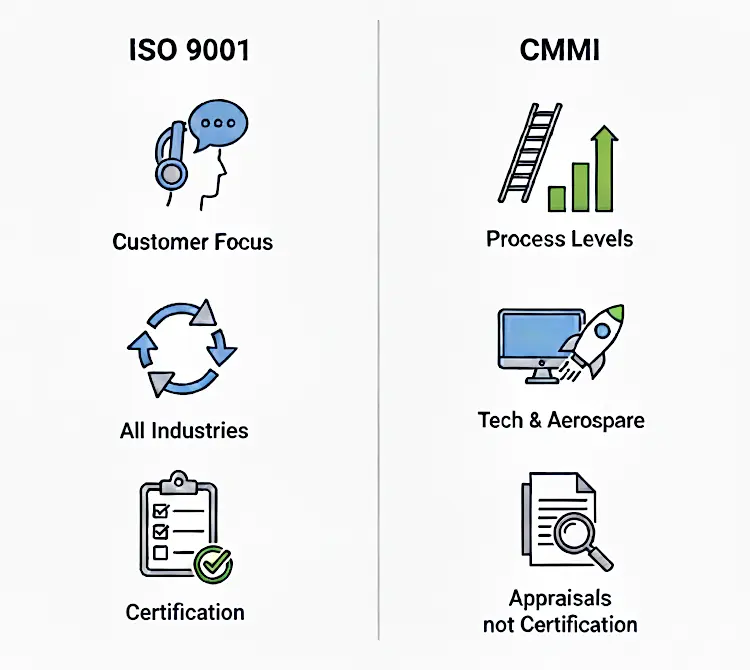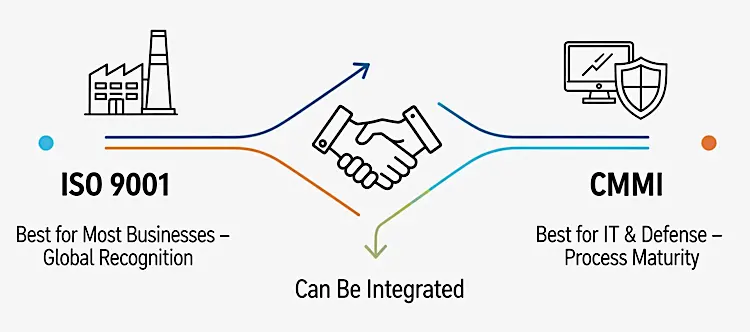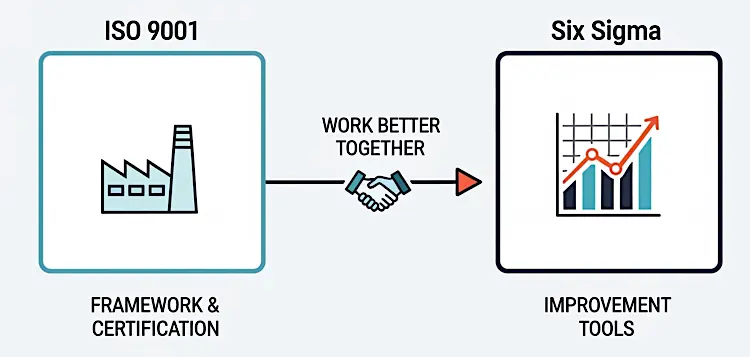CMMI vs ISO 9001: Understanding the Key Differences
24 September 2023
CMMI vs ISO 9001 is a common comparison in the world of quality and process management. Both frameworks help organizations improve performance, reduce errors, and meet customer expectations. Yet, they are not the same. CMMI focuses on process maturity, while ISO 9001 sets requirements for a quality management system (QMS).
If your company is planning for certification or improvement, the right choice depends on your goals. At 9001Simplified, we help businesses achieve ISO 9001 certification with toolkits, consulting, and training. Get started today with our ISO 9001 Certification Service designed for small and midsize businesses.

What is ISO 9001?
ISO 9001 is the world’s most recognized standard for quality management. Published by the International Organization for Standardization, it defines requirements for a QMS. Organizations use it to ensure consistent quality, meet customer needs, and comply with regulations.
Key facts about ISO 9001:
First released in 1987, latest version is ISO 9001:2015
Used by over 1 million companies in 170+ countries
Focuses on risk-based thinking, customer satisfaction, and continual improvement
Audited by third-party certification bodies
ISO 9001 certification builds trust, opens global markets, and improves efficiency.
What is CMMI?
Capability Maturity Model Integration (CMMI) is a process improvement model. Developed by the Software Engineering Institute at Carnegie Mellon University, it helps organizations improve performance across different maturity levels.
Key points about CMMI:
Focuses on process maturity, not certification alone
Structured in levels: Initial, Managed, Defined, Quantitatively Managed, Optimizing
Widely used in IT, aerospace, defense, and manufacturing
Provides appraisals rather than certification audits
CMMI is ideal for organizations that want to measure process maturity and benchmark against industry leaders.
CMMI vs ISO 9001: Core Differences
While both improve quality, their scope and approach differ.
Focus: ISO 9001 sets requirements for a QMS. CMMI measures process maturity.
Industries: ISO 9001 applies to any industry. CMMI is common in software, defense, and aerospace.
Certification: ISO 9001 offers formal third-party certification. CMMI provides appraisals.
Approach: ISO 9001 requires documented procedures and audits. CMMI encourages process improvement through staged maturity.
Global use: ISO 9001 is adopted worldwide. CMMI adoption is strong in technology and government sectors.

Why Businesses Choose ISO 9001 Over CMMI
ISO 9001 is broader and more versatile. Small businesses and manufacturers often choose ISO 9001 because:
It is recognized worldwide
It supports supply chain requirements
It improves customer trust
It offers clear certification value
At 9001Simplified, our ISO 9001 Certification Toolkit makes implementation faster, easier, and more affordable.
When CMMI is the Better Choice
CMMI works best for organizations in high-tech or defense contracts where process maturity is critical. Examples include:
Software engineering companies needing advanced process controls
Aerospace manufacturers seeking strict government compliance
Defense contractors that must prove process reliability
If you are outside these industries, ISO 9001 usually offers more direct value.

ISO 9001 vs Six Sigma
Many businesses also compare ISO 9001 vs Six Sigma. ISO 9001 sets a framework for quality management. Six Sigma provides tools and methods for reducing defects.
Key differences:
ISO 9001 ensures processes are controlled and monitored
Six Sigma improves processes using data-driven methods like DMAIC
ISO 9001 is certifiable, Six Sigma is a training-based methodology
Companies often integrate both. ISO 9001 provides the system, while Six Sigma drives improvement projects.
Six Sigma vs ISO 9001: Can They Work Together?
Yes. Six Sigma vs ISO 9001 is not an either/or choice. Many companies use both. ISO 9001 builds a QMS foundation, while Six Sigma improves performance.
For example:
ISO 9001 requires identifying risks
Six Sigma tools help analyze and reduce those risks
ISO 9001 sets monitoring requirements
Six Sigma provides statistical methods to improve control
Together, they create a powerful system for quality and efficiency.

ISO 9001 vs CMMI: Integration Possibilities
Organizations can use ISO 9001 and CMMI together. This is common in industries where both certification and process maturity matter.
Benefits of integration:
ISO 9001 certification builds external trust
CMMI improves internal processes
Combined use reduces duplication of work
Supports global competitiveness
Companies that integrate often gain higher efficiency and stronger reputations.
Commercial Value of ISO 9001 Certification
The return on investment for ISO 9001 is measurable. According to the ISO Survey, companies with ISO 9001 certification report:
20% higher customer satisfaction scores
15% reduction in process errors
Increased access to international contracts
Our ISO 9001 Certification Toolkit gives you all templates, training, and guidance needed for success.
CMMI vs ISO 9001: Which is Right for You?
Choose ISO 9001 if you want international recognition, supply chain acceptance, and broad industry value.
Choose CMMI if your contracts require process maturity appraisals or you are in defense/IT sectors.
Most small and midsize businesses benefit more from ISO 9001.
Conclusion
CMMI vs ISO 9001 is not a battle of equals. ISO 9001 sets a universal quality standard with certification value. CMMI focuses on process maturity for specific industries. For most businesses, ISO 9001 delivers broader commercial benefits and global trust.
If your organization is ready to improve quality and win new business, explore the ISO 9001 Certification Toolkit today.


